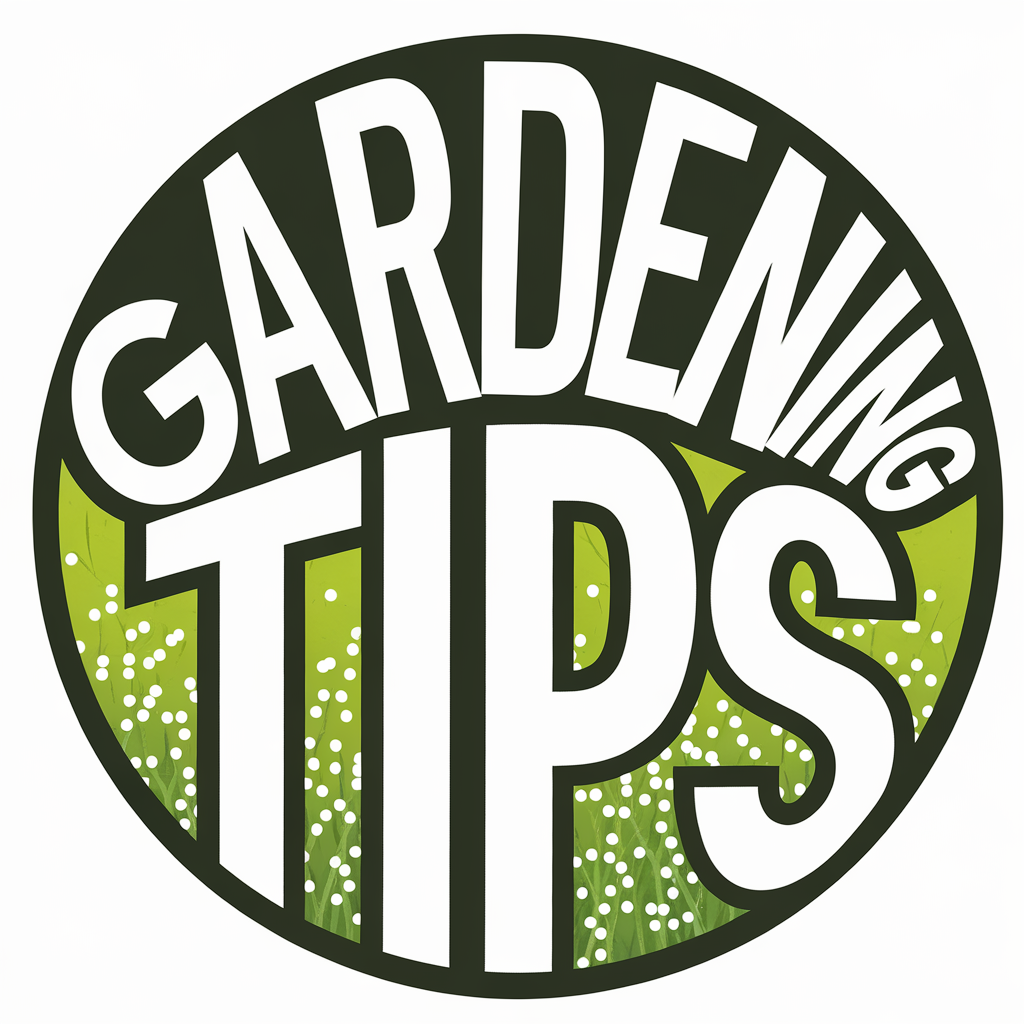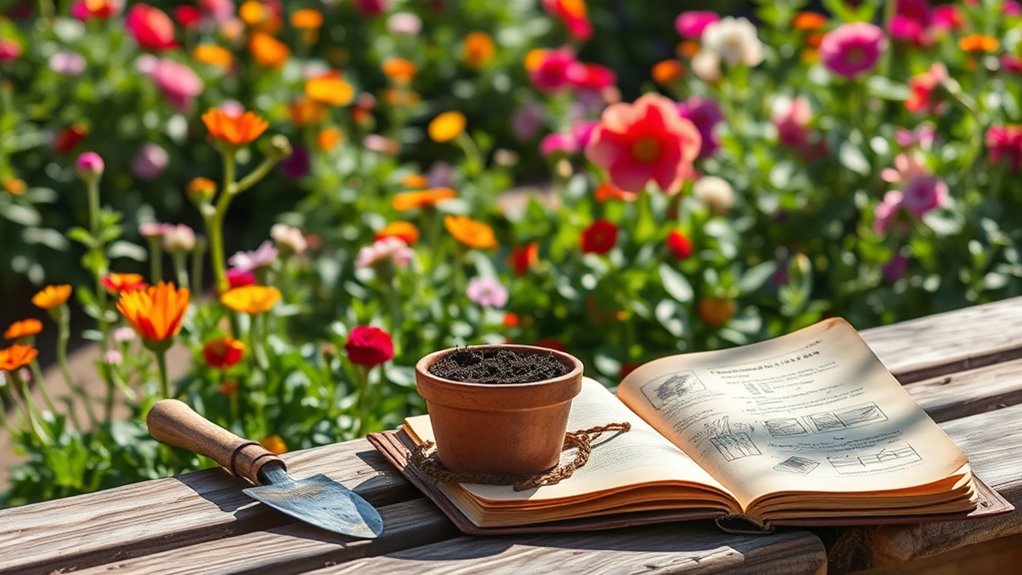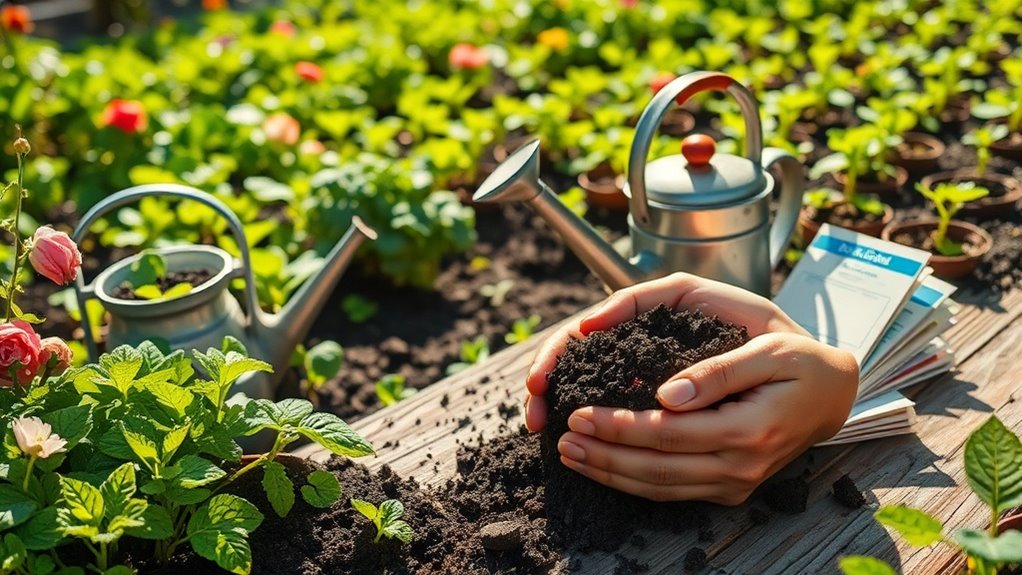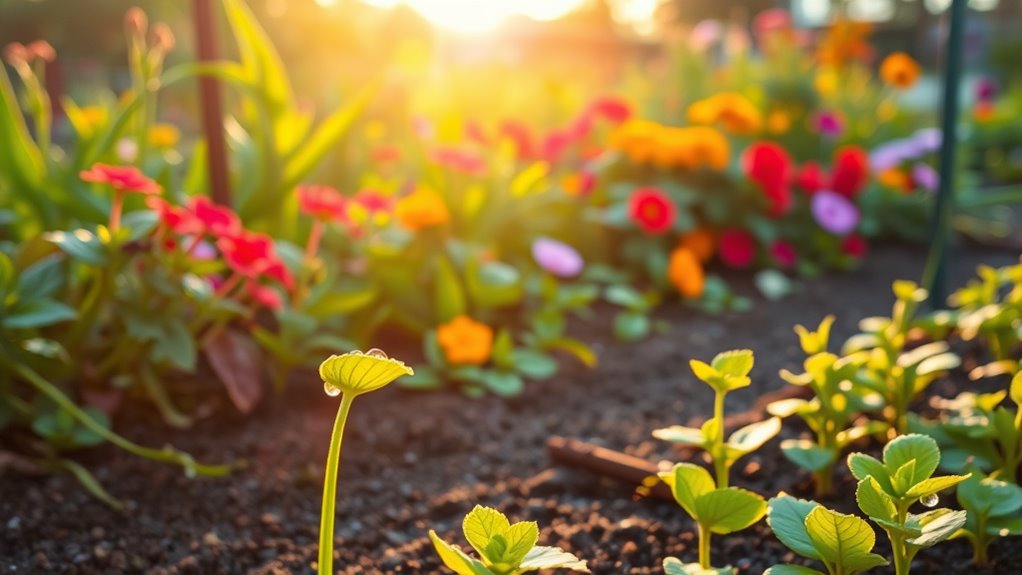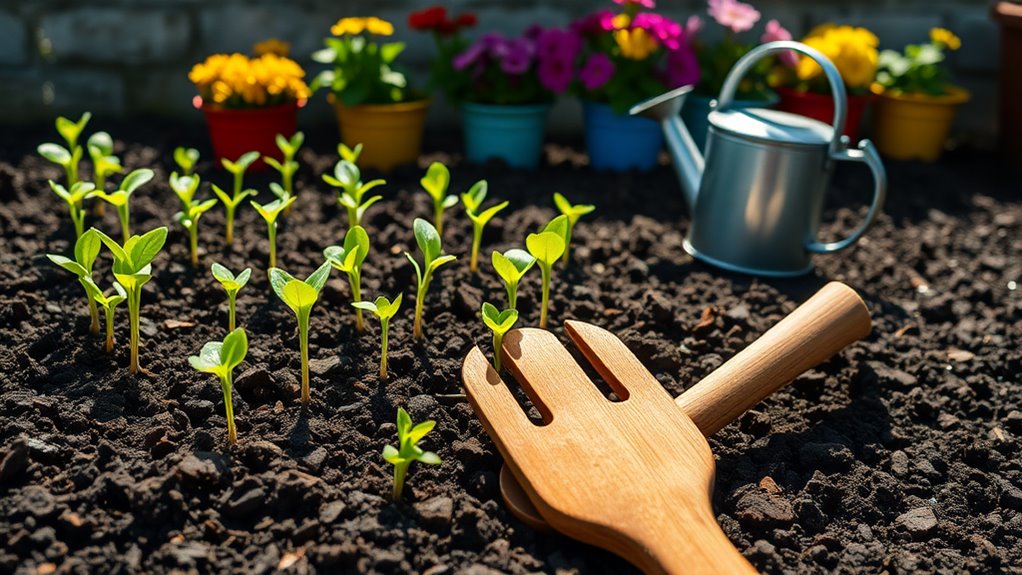The Best Gardening Tips I Learned From My Grandmother
To garden like your grandmother, start with healthy soil by adding compost and testing pH levels. Choose plants suited to your local climate and consider companion planting for a thriving garden. Water wisely early in the morning, and don’t forget to embrace natural pest control methods using garlic or peppermint oil. Practice crop rotation to maintain soil health and learn the importance of mulching for moisture retention. Discover even more timeless strategies that will elevate your gardening game!
Start With Healthy Soil
Healthy soil is the foundation of a thriving garden.
To cultivate a lush paradise, you’ll want to start with rich, organic matter. Begin by incorporating compost, which nourishes your soil with essential nutrients. This beginner wisdom sets you up for success.
Test your soil’s pH to make sure it’s balanced, allowing plants to flourish. Don’t forget to aerate; it improves drainage and promotes root growth. Additionally, conducting a soil test can help identify specific nutrient deficiencies and pH imbalances that may be affecting your plants.
As you dig and mix, envision the vibrant blooms and bountiful yields that await you.
With healthy soil, you’re not just planting seeds; you’re nurturing a vibrant ecosystem that will inspire you season after season.
Choose the Right Plants
Choosing the right plants is essential for a thriving garden, and it starts with understanding your local climate and soil type.
By selecting plants that thrive in your conditions, you’ll set the stage for vibrant growth and bountiful blooms.
Plus, considering companion planting can enhance your garden’s health and productivity, creating a harmonious ecosystem right in your backyard. Certain plant combinations can enhance growth and deter pests, ensuring a flourishing garden throughout the seasons.
Local Climate Considerations
When you consider your local climate, the right plants will flourish in your garden, transforming your outdoor space into a vibrant sanctuary. Understanding your climate zone helps you select plants that thrive in your area, ensuring a bountiful garden. Here’s a quick reference table to guide your choices:
| Climate Type | Suitable Plants | Blooming Season |
|---|---|---|
| Tropical | Hibiscus, Bougainvillea | Year-round |
| Temperate | Roses, Lavender | Spring to Summer |
| Arid | Succulents, Cacti | Spring to Fall |
| Cold | Pansies, Evergreens | Spring, Fall |
Choose wisely, and watch your garden thrive!
Soil Type Selection
Selecting the right soil type is just as important as knowing your local climate. Healthy plants thrive in soil that meets their specific needs.
For instance, sandy soil drains quickly, making it ideal for drought-tolerant plants, while clay retains moisture, perfect for moisture-loving varieties. Loamy soil strikes a balance, supporting a wide range of plants.
Test your soil to understand its composition, and amend it with organic matter if necessary.
Companion Planting Benefits
Companion planting can transform your garden into a thriving ecosystem, where plants work together to enhance growth and deter pests.
By pairing crops like tomatoes with basil, you’ll not only boost flavor but also repel harmful insects.
Consider planting marigolds alongside vegetables; their vibrant blooms attract beneficial pollinators and ward off nematodes.
When you choose the right plants, you create natural synergy, maximizing space and yield.
Experimenting with combinations brings excitement to gardening, allowing you to discover what thrives best together.
Embrace this age-old wisdom, and watch your garden flourish in ways you never thought possible.
Water Wisely
How can you guarantee your plants thrive while conserving water?
Start by watering early in the morning or late in the evening when temperatures are cooler. This minimizes evaporation and lets moisture penetrate the soil.
Use mulch to retain moisture, reducing the need for frequent watering. Opt for drip irrigation or soaker hoses to deliver water directly to the roots.
Observe your plants; they’ll tell you when they’re thirsty. Aim for deep, infrequent watering instead of shallow, daily sips. Additionally, understanding effective watering timing can enhance your irrigation practices for optimal plant health.
With these methods, you’ll nurture your garden sustainably, guaranteeing each drop counts and your plants flourish beautifully.
Embrace Companion Planting
Unlock the potential of your garden by embracing companion planting, a technique that pairs compatible plants to enhance growth and deter pests.
This method creates a thriving ecosystem, where plants support each other in remarkable ways. Consider these powerful pairings:
- Tomatoes and Basil: The aromatic basil wards off pests while enhancing the flavor of your tomatoes, making this pairing a prime example of the power of basil and tomato pairing.
- Carrots and Onions: They naturally repel each other’s pests, leading to healthier crops.
- Marigolds and Beans: Marigolds attract beneficial insects and improve bean growth.
Use Natural Pest Control
When it comes to keeping your garden thriving, natural pest control is your best friend.
You can craft homemade insect repellents, utilize companion planting strategies, and invite beneficial insects to create a balanced ecosystem. One effective option is a simple DIY pest spray made from natural ingredients, which can help deter unwanted pests while maintaining a healthy garden.
Homemade Insect Repellents
Have you ever wondered how to protect your garden from pesky pests without resorting to harsh chemicals?
You can create effective homemade insect repellents that are safe for your plants and the environment.
Here are three simple recipes to try:
- Garlic Spray: Blend a few cloves of garlic with water, strain, and spray on affected plants to deter insects.
- Soap Solution: Mix mild liquid soap with water and spray directly on pests to suffocate them.
- Peppermint Oil: Combine water and a few drops of peppermint oil; spray around your garden for an invigorating deterrent.
Embrace nature’s solutions and watch your garden thrive!
Companion Planting Strategies
Companion planting offers a natural approach to pest control, transforming your garden into a thriving ecosystem.
By pairing plants that naturally repel pests, you can create a harmonious environment.
For instance, marigolds deter nematodes, while basil wards off flies and mosquitoes. Planting garlic near roses can keep aphids at bay.
This strategy not only protects your crops but also boosts growth and flavor.
Embrace the wisdom of nature by observing which plants thrive together, and watch your garden flourish.
With a little creativity and planning, you’ll cultivate a vibrant space where plants support each other, ensuring a bountiful harvest without harsh chemicals.
Beneficial Insects Role
How can you invite beneficial insects into your garden to enhance natural pest control?
These tiny allies can transform your garden into a thriving ecosystem.
Here’s how to attract them:
-
Plant Diverse Flowers: Choose a variety of nectar-rich blooms like marigolds and sunflowers to provide food and shelter.
-
Create Habitats: Leave a small patch of wildflowers or install insect hotels to encourage ladybugs and lacewings to settle.
-
Avoid Pesticides: Embrace organic methods; harmful chemicals deter beneficial insects.
Practice Crop Rotation
Crop rotation is an essential practice that can greatly enhance your garden’s health and productivity. By alternating the types of crops you grow each season, you can prevent nutrient depletion and reduce pest and disease buildup.
For instance, follow heavy feeders like tomatoes with lighter crops such as beans. This way, you’ll maintain soil fertility and promote a balanced ecosystem. Additionally, incorporating organic gardening hacks can further optimize your soil health and plant growth.
Not only does it keep your plants thriving, but it also keeps gardening exciting as you experiment with different varieties each year. Embrace crop rotation, and watch your garden flourish like never before, just as my grandmother taught me.
Learn the Importance of Mulching
Have you ever wondered how a simple layer of material can transform your garden into a thriving paradise?
Mulching is your garden’s best friend, offering countless benefits.
Here are three reasons to embrace it:
- Moisture Retention: It keeps soil hydrated, reducing watering needs and ensuring your plants thrive during dry spells.
- Weed Suppression: A thick layer blocks sunlight, preventing pesky weeds from sprouting.
- Soil Enrichment: Over time, organic mulches decompose, enriching the soil with nutrients. Additionally, different mulch types can have varying effects on plant health, making it essential to choose wisely.
Keep a Gardening Journal
Ever wondered why so many gardeners swear by keeping a journal? It’s your personal treasure trove of knowledge.
Documenting your planting dates, weather patterns, and plant performance helps you track successes and failures. You’ll discover what thrives in your unique environment.
Plus, it’s a great space to jot down inspiration, sketches, or photos of your garden’s evolution.
As you turn the pages, you’ll see your growth—both as a gardener and in your garden’s beauty.
